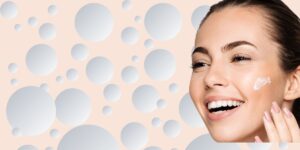Introduction
Lactic acid is a common alpha-hydroxy-acid (AHA) used in many skincare treatments. It is a naturally occurring, water-soluble, organic acid found in milk and dairy products. Unlike other AHAs such as glycolic acid, lactic acid is also a vital part of our skin’s Natural Moisturising Factor (NMF)1, our skin’s natural hydrating system.
Lactic acid functions as a skin exfoliator to peel off dead layers of cells in the stratum corneum and stimulate skin renewal. It can stimulate collagen production to restore healthy tissue for a more youthful skin appearance.
The first generation hydroxy acids (AHAs) such as glycolic acid can be skin irritating whereas lactic acid is more gentle, but can be slightly less effective2.
Benefits for Your Skin
“Antiaging effects of cosmetic alpha-hydroxy acids (AHAs) have been demonstrated in rigorous clinical studies that have been published in peer-reviewed journals.”3
The skin benefits offered by lactic acid treatment are well established and well supported by research. Hydroxy acids offer the following skincare benefits:
1. Dry Skin Treatment
Treatment of dry skin conditions with AHAs restores the startum corneum and the epidermis to a more normal clinical and healthy state4. Lactic acid forms a vital part of our skin’s Natural Moisturising Factor (NMF)1, our skin’s natural hydrating system.
2. Sensitive Skin
Lactic acid is less skin irritating and more gentle than other AHAs such as glycolic acid2.
3. Hyperpigmentation Treatment
With sustained treatment by Lactic acid, lightening and even complete fading of hyperpigmentation can be achieved.
4. Anti-aging, Photoaging Treatment
Antiaging benefits of reduced wrinkles and fine lines can be achieved with the daily application of lactic acid to the skin4. This can result in increase in dermal thickness and firmness that persists after application ceases. AHAs increase skin production of collagen and hyaluronic acid which result in thicker and firmer skin.
5. Peeling Agents
Lactic acid is commonly used in chemical peeling procedures. At lower concentrations it can be used as at-home gentle peel to increase skin exfoliation and cell turnover. As we age our skin cells turnover slows down and this contributes to the aging process. Lactic acid is slightly less effective as a chemical peel than glycolic acid but it is better tolerated with a lower incidence of skin irritation2. It is more effective than Vitamin C in treating some skin pigmentation conditions2.
6. Enhance Skin Barrier Function
The Stratum Corneum is the thin outer layer of cells that protect the skin from attack by environmental factors. Lactic acid forms an important part of the skin barrier function. FIrstly, it is an important moisturising factor in maintaining skin hydration levels1. Secondly, it can enhance the skin barrier function by increasing ceramides within the stratum corneum.
7. Acne and Acne Scar Treatment
The skin peeling and desquamation effects of AHAs, BHAs and PHAs make them suitable for the treatment of acne5. Lactic acid, combining moisturising effects, is one of the best peeling agents for treatment of acne and acne scars.
Discussion
“Lactic acid, as well as being a component of the NMF, is also a member of the class of molecules called alpha hydroxy acids (AHAs), which exert specific and unique benefits on skin structure and function.”1
Lactic acid is our preferred AHA for hydroxy acid antiaging treatment because it is also a powerful skin hydrating agent. However lactic acid combined with occlusive agents provides an enhanced skincare treatment. Using our Green Micelle™ nano-technology, we can combine lactic acid with natural emolients to provide a potent but gentle antiaging serum. Nano-encapsulation of active ingredients provides both enhanced ingredient stability and superior skin penetration of hydroxy acids.
References
- 1.Harding C, Rawlings A. Effects of Natural Moisturizing Factor and Lactic Acid Isomers on Skin Function. In: Dry Skin and Moisturizers: Chemistry and Function. CRC Press; 2005:187-204.
- 2.Dayal S, Sahu P, Jain V, Khetri S. Clinical efficacy and safety of 20% glycolic peel, 15% lactic peel, and topical 20% vitamin C in constitutional type of periorbital melanosis: a comparative study. J Cosmet Dermatol. 2016;15(4):367-373. doi:10.1111/jocd.12255
- 3.Green BA, Sabherwal Y. Antiaging Benefit Ingredients: AHAs, BHAs, and Bionic Acids. In: Procedures in Cosmetic Dermatology. 3rd ed. Elsevier; 2016:99-116.
- 4.Green B, Yu R, Van S. Clinical and cosmeceutical uses of hydroxyacids. Clin Dermatol. 2009;27(5):495-501. doi:10.1016/j.clindermatol.2009.06.023
- 5.Decker A, Graber E. Over-the-counter Acne Treatments: A Review. J Clin Aesthet Dermatol. 2012;5(5):32-40. https://www.ncbi.nlm.nih.gov/pubmed/22808307












